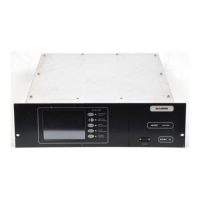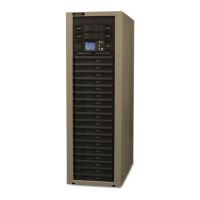______________________________________________HARRIS
888-9058-001
WARNING: Disconnect and lockout AC primary power prior to servicing
184
Likewise, a minimum voltage reference is established by R45 and R46. If the reference
exceeds the DC supply sample, U7 pin 2 is driven high, indicating an under-voltage
fault.
* Monitors ISO voltage samples of the quarter modules, protecting the amplifier from
damage due to imbalances between the two halves of a quarter module. The ISO
voltage samples are combined by a OR circuit and collected at J1-3, 4, 16 and 17 on the
controller board.
A reference is established by R38 and R81. If the ISO voltage sample exceeds the
reference, U6 pin 13 is driven low, indicating a fault.
* Monitors the temperature of the quarter modules, turning off the amplifier if excessive
temperatures are encountered. A voltage is developed on each module by the thermistor
circuitry that is proportional to the heat sink temperature. These voltages are routed to
the module controller board, J1-5, 6, 7 and 8. The voltages are compared to a reference
by comparator U13. If any quarter module temperature voltage is lower than the
reference, the comparator output will go low. This switches the output of the Schmitt
trigger high.
*Enables the 50 Volts DC to the quarter modules by controlling a pair of high-power
switching FETs (pass FETs) located on the module rear panel. If no faults are present,
PAL U1 pin 12 sends a signal to U7 pin 8, which controls a circuit that turns on the pass
FETs, a pair of n-channel switching FETs. If a fault condition occurs, the switching
FETs are turned off.
The switched 50 Volts dc is reduced to 15 Volts by R39 and U10. This 15 Volts is routed
to each quarter module for bias circuitry power.
The incoming 50 Volt DC power is switched on and off by the pass FET assembly,
controlling the application of 50 Volts to the Quarter Modules. This switched 50 Volts is
reduced to 15 Volts by regulator U10. The +15 is supplied to each module to be used for
temperature sensing and FET biasing.
The logic will not allow the module to enable if a fault condition exists, to protect the
module from damage.
8.2.9 Module Status LEDs
Each module uses two front panel LEDs to display its current operating status. The
LEDs are driven by signals from the PALs and U8 and U9, which are NAND gates
configured as buffers. The status can be interpreted from the LEDs as follows:
Steady Red - 50 Volts applied to the module, but the module is not enabled. This will
normally occur if a module is removed and then reinserted in the slot. The red LEDs
will illuminate then fade out as the supply capacitors discharge each time the transmitter
is turned off.
